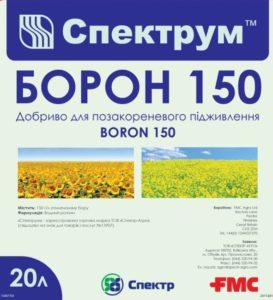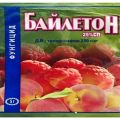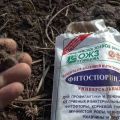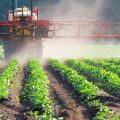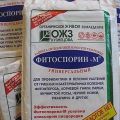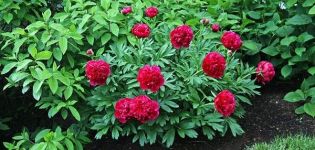Instructions for use of the fungicide Penncoceb
The use of the fungicide Penncoceb is due to its high efficiency in the fight against scab, fruit rot, late blight and macrosporiosis. Due to the mechanism of action, the drug destroys pests without harm to crops. It is also easy to use and, subject to safety regulations, does not pose a danger to the human body.
Content
- 1 Description, purpose and form of release of the fungicide Penncoceb
- 2 The mechanism of action of the agent
- 3 Advantages and disadvantages of the drug
- 4 Consumption rate
- 5 Methods for preparing the working solution
- 6 Further use of the fungicide
- 7 Safety engineering
- 8 Can the solution harm
- 9 Phytotoxicity
- 10 Compatibility
- 11 Storage rules
- 12 Are there any analogues?
Description, purpose and form of release of the fungicide Penncoceb
The drug is available in powder form. The main active ingredient of the product is mancozeb, which is 80% of the fungicide. In addition, the composition
Penncoceba contains magnesium and potassium supplements to increase the vitality of crops.
The product is used to protect plants from harmful microorganisms and diseases. The duration of the period of protective action is 10-15 days.
The mechanism of action of the agent
Fungicide Penncoceb belongs to contact drugs. It is applied to the stems and leaves of plants by spraying. After that, the active components of the drug begin to act on pathogenic microorganisms, suppressing their development and reproduction processes, as a result of which the pests die.
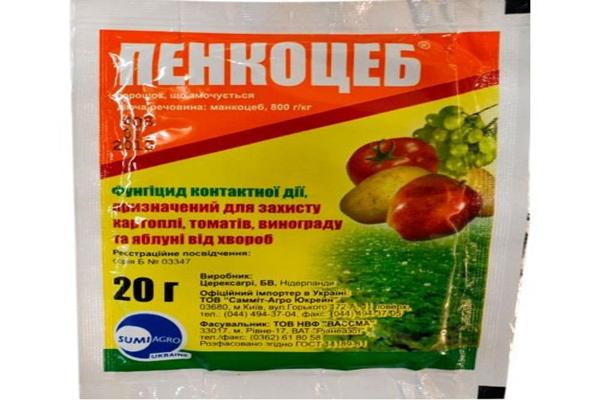
Advantages and disadvantages of the drug
The main advantage of the product is the reliable protection of plant crops from sensitive forms of pathogenic organisms. Also among the advantages of the fungicide Penncoceb are:
- exclusion of the possibility of developing resistance to the components of the drug;
- stimulation of photosynthesis processes thanks to manganese and zinc, which are part of the product;
- availability and ease of use;
- water soluble powder does not wash moisture from plants or soil;
- is not phytotoxic in relation to other crops;
- increasing planting yields;
- the possibility of using in combination with other tank mixtures.
A serious drawback of the drug is its high toxicity. It belongs to the 2nd class of hazard. This means that the drug can harm human health.

Consumption rate
When treating vineyards from mildew, 20-30 grams of the product are used per 10 liters of water. The number of treatments per season is 3-4 times. In the case of spraying potatoes and tomatoes from late blight or macrosporiosis, 12-16 grams of fungicide are needed per 10 liters of water. This is enough to process 1 hundred square meters of landings. The period between processing and harvesting must be at least 20 days.
Also, the fungicide Pennkoceb is used to protect apple and pear trees from scab along with fruit rot. To do this, stir 20 grams of the drug in 10 liters of water.
The number of treatments for fruit crops per season is 3-4 times.
Methods for preparing the working solution
It is recommended to prepare a working solution on the day of plant processing. To do this, dissolve 12-20 grams of powder in 10 liters of water. First, a third of the liquid is poured into the sprayer tank, then the agent is poured and the solution is thoroughly mixed. Then add the rest of the water and start spraying the desired crops.

Further use of the fungicide
The drug is used as a prophylactic agent that can prevent damage to plant crops by a fungus. In addition, it is used to treat diseased plants according to the instructions. Plants need to be processed about 3-4 times per season. In this case, the interval between spraying should be at least 10 days.
Safety engineering
The fungicide belongs to the 2nd class of toxicity. This means that it is dangerous to human health and honey insects. To prevent intoxication of the body, you must adhere to safety rules. These include:
- Having a change of clothing that can be used when working with a chemical. To do this, you need to use things made of thick fabric. It is also recommended to have personal protective equipment in the form of a headgear, vacuum glasses, respirators for respiratory protection, and a rubber apron.
- Checking the condition of the sprayer with water.
- The procedure is recommended in the absence of wind and rain, in the morning or evening.
- It is not recommended to drink, eat or smoke during the procedure, as this can lead to intoxication of the body.
- After processing, you need to neutralize the tank for spraying with 5% soda solution or laundry soap.
- Spraying should not be carried out for children, lactating and pregnant women, as well as for people who have an increased sensitivity to the components of the drug.

Can the solution harm
The drug belongs to the 2nd class of toxicity. It is dangerous to human health. Inhalation of drops or vapors of the agent may damage the respiratory organs with further intoxication of the body.
Phytotoxicity
The product has no phytotoxicity when processing plant crops. Subject to the instructions for use of the drug, it is not dangerous for the environment. Nevertheless, there is evidence that, during an exaggeration of the norm, undesirable phytotoxicity may develop on fruit plants.
Compatibility
Fungicide Penncoceb can be combined with most preparations for spraying garden and fruit crops. Before complex treatment of plants, it is recommended to check the products for chemical compatibility.

Storage rules
The drug can be stored for no more than 4 years from the date of manufacture. It is recommended to store the product away from household items and food. The room temperature should not exceed 25 ° C. Fungicide should be kept in closed containers at all times.
Are there any analogues?
If it is not possible to purchase the drug, it is recommended to use the fungicides Bayleton, T-Rex and Bayzafon. These alternatives have a similar composition and effect, which makes them suitable for use as a replacement for the main pesticide.

Fungicide Penncoceb is one of the most effective drugs that will protect crops from scab, fruit rot, late blight and macrosporiosis.The use of such substances is effective if the instructions for use are followed, as well as safety regulations. This will make spraying healthy and beneficial to the crop.
